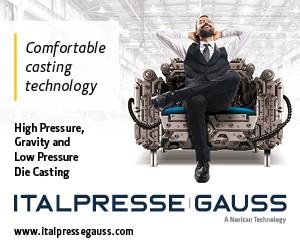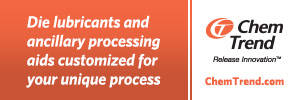The element zinc, with a specific gravity of 7.0, is among the heavier of the common structural metals. It is somewhat less dense than iron (s.g. 7.7) and copper (s.g. 9.0). When used as a base for die casting alloys, zinc is alloyed with aluminum, copper and magnesium. Other elements present in the alloys are regarded as impurities, and maximum limits, expressed as single numbers are specified.
There are four alloys in the conventional zinc group, which are often referred to commercially as the “Zamak” alloys (an acronym for zinc, aluminum, magnesium and copper). These alloys, with their ASTM designations, are:
| Zinc 2 | ASTM AC43A |
| Zinc 3 | ASTM AG40A |
| Zinc 5 | ASTM AC41A |
| Zinc 7 | ASTM AG40B |
Aluminum, Copper & Magnesium in Zinc
The nominal aluminum content of each alloy is 4%. Aluminum gives the alloy its mechanical properties, particularly tensile and impact strengths. The relatively low aluminum concentration gives the alloys very low melting points, makes them easy to cast, and allows for extended die life.
Copper, in small amounts, increases tensile strength and hardness, but reduces ductility, particularly in the aged condition. Zinc 2 and 5 have nominal copper contents of 3% and 1% respectively. Copper is restricted to a maximum of 0.25% in zinc 3 and 7.
Magnesium, in very small amounts, also increases hardness and reduces ductility. Its main purpose is to offset the effects of metallic impurities, particularly lead, cadmium and tin.
Restricted Elements in Zinc
Iron, lead, cadmium and tin have been identified as undesirable elements and are restricted to low or extremely low levels. Higher iron contents form undesirable intermetallic particles. Lead, cadmium and tin, even in very low concentrations, can cause intergranular corrosion in the crystal structure of the zinc-aluminum alloy system when magnesium is absent. The as-cast allowable levels of these elements are:
As Cast Zinc Alloy Restricted Elements Concentration, % (parts per million)
| Zinc 2 | Zinc 3 & 5 | Zinc 7 | |
|---|---|---|---|
| Fe Iron | 0.10 (1000) | 0.10 (1000) | 0.075 (750) |
| Pb Lead | 0.005 (50) | 0.005 (50) | 0.003 (30) |
| Cd Cadmium | 0.004 (40) | 0.004 (40) | 0.002 (20) |
| Sn Tin | 0.003 (30) | 0.003 (30) | 0.001 (10) |
These high-purity limits can be maintained only by using special high-grade zinc, with a purity of 99.990%, as a base. Zinc suppliers, through many years of development, routinely produce primary metal that meets the purity standard. All of the zinc (and ZA) alloys produced in the U.S. and Canada are made from primary metal that meets the purity specification.
Zinc 3 and 5 were introduced in the 1930’s, and zinc 7 was introduced approximately 20 years later. Since their introduction, purity of the base zinc has been increased to its current level of 99.990%, decreasing the undesirable elements and reducing the levels of magnesium which is required to offset them. These improvements have led to higher ductility and more consistent quality.
The mechanical properties of the alloys have been extensively characterized. Long-term data on creep and aging have been developed, allowing the designer to predict with confidence the performance of alloy die castings over the projected product life.
Zinc Alloys – No. 3, 5 & 7
Zinc 3 is the workhorse alloy of this group, and specified most frequently. Many zinc die casters use only this alloy, making it unnecessary for them to segregate in-house scrap. It has a slight cost advantage over zinc 5, and since more die casters use it, price quotations are potentially more competitive.
Zinc 5 offers high tensile strength, harness, and creep resistance than zinc 3, and somewhat lower ductility. It is preferred whenever these properties are required. Some die casters use only zinc 5, which is usually an acceptable alternative to zinc 3.
Zinc 7 is essentially a high purity form of zinc 3 with slightly higher ductility and lower hardness. The other mechanical properties are identical to zinc 3. The alloy also exhibits higher fluidity than zinc 3 or 5, which theoretically allows slightly higher production rates and thinner walls. Zinc 7 may be specified when high ductility is required.
Proprietary Zinc Alloys
Proprietary zinc alloys have also been developed with improved properties. The Patio Awning Lift Handle Base shown is made from a zinc alloy containing 5% copper and out performed zinc 3 and 5. The higher strength alloy allowed the Lift Handle Base to carry heavy water and wind loads placed on the awning during its use.
Common Properties
Zinc alloys 3, 5 and 7 have a number of properties in common, deriving from their common zinc base and similar composition.
- Mechanical properties: All alloys exhibit the same modulus of elasticity, shear modulus and Poisons’ ratio. Compressive strength is approximately 50% higher than tensile. The room temperature impact strength of zinc alloys is the highest of all die cast alloys.
- Temperature effects: Data for mechanical properties are taken at room temperature, and some vary significantly with relatively minor changes in temperature. The effect of temperature on the properties of zinc 3 and 5 have been documented and published by the zinc industry.
- Casting properties: Zinc alloys exhibit little tendency to attack steel at casting temperatures. This property, combined with the relatively low casting temperature, results in low die maintenance and long die life. These properties also allow zinc alloys to be cast using the hot-chamber method.
- Platability: Zinc alloys can be economically plated to achieve a bright, durable chrome finish. This makes them the die casting material of choice for hardware applications.
- Aging: The die casting process is characterized by very rapid metal solidification. The phenomenon locks zinc alloys into a crystal structure that is not stable at room temperature.
Zinc Aging
Over time, the metal molecules slowly migrate to a stable pattern, a condition known as aging, with two effects:
– Ductility is increased slightly, and tensile strength, impact strength and hardness are somewhat decreased.
– There is slight shrinkage.
Changes in ductility and tensile strength occur over a period of approximately 10 years at room temperature. Shrinkage is 0.0007 in./in., of which 0.0005 in. occurs within five weeks at room temperature. If the castings are quenched, an additional 0.004 in. shrinkage occurs.
If desirable, the aging process can be accelerated by oven heating according to the following schedule:
- 3 hours at 212°F (100°C)
- 5 hours at 185°F (85°C)
- 10 hours at 158°F ( 70°C)








